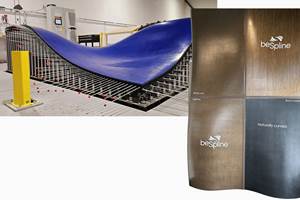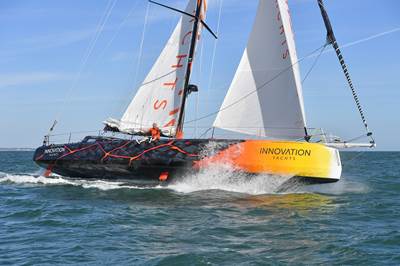Evolving natural fiber technology to meet industry sustainability needs
From flax fiber composite boats to RV exterior panels to a circularity model with partnerships in various end markets, Greenboats strives toward its biomaterials and sustainable composites vision in an ever-changing market.
As a company specializing in natural fiber composites technology, Greenboats GmbH has learned to adapt its product offerings to meet market demands, expanding its portfolio from flax fiber/bio-based resin boats, to high-volume production of sandwich panels, to campers. Source | Greenboats
Bio-based composite materials like natural fibers and plant-sourced resins are no longer the shiny new toys they were a few years ago. As initial excitement and newness evolves into proving out the staying power of bio-based materials for the right composite applications, companies working in this space are evolving with them to provide the solutions the industry needs.
Greenboats GmbH (Bremen, Germany), founded in 2013 by accomplished boatbuilder Friedrich J. Deimann, is one example of how companies have learned to adapt in the natural fiber composites space. Deimann had seen success building boats from both wood and fiberglass composites and wanted to merge the two technologies to build vessels from natural, less toxic materials that maintain the light weight and high performance of composites. Aiming to meet these goals from the start, Greenboats focused on building boats that incorporate as much flax fiber composites as possible.
Jan Paul Schirmer, managing director at Greenboats, came on board early on to run the business side of the company. He says, “When [Deimann and I] started working together, we had a very clear agenda about how we wanted to strive toward sustainability in this space, but we identified a number of issues from the start,” which the team spent the next few years working through.
First, manufacturing with natural fibers can be a challenge. Learning to build infused boat hulls with these materials was a trial-and-error process. “There are so many variables to control,” Schirmer says. “You need to avoid moisture and control humidity, natural fibers process at different temperatures and pressures than other materials, and so on.”
The entire exterior and inner structures for the Flax27 Daysailer are built with infused flax fiber composites with a bio-based epoxy and recycled PET foam core. Source | Greenboats
In addition, he explains that securing a natural fiber supplier that can provide the needed amounts of high-quality, consistent materials is paramount. In 2021, Greenboats began working with Groupe Depestele (Normandy, France), a large flax farming cooperative. “In my opinion, they produce the best flax for composite applications. So this was a very important step for us,” Schirmer says.
Regardless of supplier, the relatively high material costs of natural fibers compared to fiberglass are also a challenge, and led the company to think from the beginning about how to reduce labor costs through automation and modular products to balance out total cost per part.
In 2016, the startup built its first 7.5-meter sailing boat, constructed from flax fiber, cork and a bio-based epoxy sourced from linseed oil. “It was Deimann’s breakthrough in a way, getting a lot of media attention and winning several awards,” Schirmer says. From there, the company began building and selling custom-built natural fiber composite sailboats, and that’s still a large part of its business today.
However, Schirmer explains that because natural fiber composite boats are always going to be a premium niche option compared to fiberglass composite boats, he saw an opportunity “to position ourselves as not just a boat manufacturing company, but as a technology company” specializing in natural fiber composites.
With this goal in mind, for its second product, Greenboats looked outside the box to modular, natural fiber composite sandwich panels.
Natural fiber sandwich panels, custom parts
“We identified early on that sandwich panels would be the real solution to scaling up natural fiber composites,” Schirmer says. “The material costs are hard to control, but with these, you can reduce labor and manufacturing costs by producing a high-volume, standardized, easy-to-assemble product.”
First, Greenboats tested out production of 1.3 × 3-meter compression molded flax fiber/bio-epoxy panels using a press it already had, and then, after achieving early successes, invested in a larger compression press to manufacture up to 6 × 2.5-meter panels. This system is located at a separate, nearby facility and operated in cooperation with the company’s manufacturing partner Fassmer (Berne, Germany).
With production partner Fassmer, Greenboats is capable of producing sandwich panels up to 6 × 2.5 meters, suited for a variety of applications from recreational vehicle exteriors to wind turbine nacelles. Source | Greenboats
Using this press, the company is currently able to produce up to 1,000 square meters of laminated skins per day — generally made from a noncrimp woven flax textile and one of 10 or so different resin systems, ranging from 100% bio-based to more traditional non-bio resins — that can be combined with a recycled and/or bio-based foam and low-density wood such as balsa.
“From an economics perspective, this was a great step for us. We went from 50% of a part’s cost coming from labor and production to less than 10%,” Schirmer says.
Despite its relatively small core team, Greenboats does a lot these days: It can engineer and prototype custom natural fiber composite parts and manufacture series of up to several thousand per year; mass-produce sandwich panels; or even sell the textiles themselves. And yes, the company does also still build boats. “How we see it is that we’re experts in natural fiber technology, and we want to support companies where they are in this journey,” Schirmer says.
Over the last few years, the company has had a hand in developing a number of new parts in various industries, from playground slides, to a wind blade nacelle demonstrator, to wall-mounted electric vehicle charging ports. Then, in 2024, Greenboats launched its latest application, the Greenlander Sherpa recreational vehicle (RV).
Greenlander Sherpa
The Greenlander Sherpa is a premium camper developed by Greenboats with design partner Langefreunde Design Studio (Schwerin, Germany) and manufacturing partner Borco Höhns GmbH (Rotenburg, Germany).
All of the exterior structures for the camper are constructed from Greenboats’ flax fiber composite sandwich panels. The company built the first few iterations of the RV, which was presented to the composites industry at the JEC World 2024 trade show in Paris, France, and to the RV industry at the Caravan Salon 2024 in Düsseldorf, Germany, at its own facility. Ultimately, partner Borco Höhns will build the production vehicles using panels supplied by Greenboats.
This product, Schirmer says, represented a way for the company to showcase the potential of its panels and the types of applications they are suited for while also creating a consumer product that fits with Greenboats’ premium RV brand. According to him, early feedback from the industry and customers has been very positive.
“With this project, we’ve started delving into the circular economy as well,” he adds. One goal is for customers to be able to return Greenlander Sherpa vehicles back to Greenboats at their end of life, and for the company to reuse the composite panels to build new campers or other applications.
Representing a new end market for Greenboats, the Greenlander Sherpa was launchd at JEC World 2024 and the Caravan Salon 2024. Source | Greenboats
A circular economy model
The Greenlander Sherpa project led Greenboats to the latest iteration of its business model, which it calls its Circular Structures platform, launched at JEC World 2024.
Part of the impetus for this platform is economic, Schirmer admits. One way to market a premium natural fiber composite product versus a less expensive option is to add the benefit of full recyclability — customers can return a part or panel back to Greenboats at the end of its life for recycling or reuse.
“Another part of this model is design for recycling — designing components from the outset anticipating how it will be reused for a second or third lifespan,” Schirmer says.
How does this work, logistically? One method is to sell products with a specific lifespan already in mind — at the point of sale, the client already knows they will return the products to Greenboats after a certain number of years, for example. Another way to do this that Greenboats has considered is to attach sensors to the manufactured laminate for structural health monitoring. “So when a part comes back to the plant, we have data on its structural integrity,” Schirmer explains. Either method, or a combination of both, allows Greenboats to plan ahead and anticipate what materials will be returned to them in a given time frame.
What happens to a product when it’s returned to Greenboats? Assuming it is structurally sound and undamaged, the company’s technicians can simply treat the surface of the laminate to make it look new again and then resell — even to the same client — at a lower rate for a new application. The idea is to create an ecosystem where sustainability is as simple as possible for consumers.
“This is our vision,” Schirmer explains. “We have two levels to our sustainability goals. One, we use materials that have a lower CO2 impact compared to typical materials on the market. That’s natural fiber composites, that’s bio-based resins and recycled or plant-based core materials. Two, we use every product as many times as it can be used. That’s circularity.”
Next steps: Continuing innovation, adapting to market changes and challenges
Beyond boats and campers, Greenboats has produced prototypes or series parts for a variety of customers, including this electric vehicle charging station cover that was on display at the company’s JEC World 2024 booth. Source | CW
Along with discovering new market opportunities, Greenboats continues to improve its materials and process capabilities. This includes increasing automation, particularly in its panel manufacturing process. “We were able to drive down process costs significantly by investing in the larger press — our costs per square meter are decreased by a factor of 10 compared to the smaller machine. We’re really happy with the results,” says Schirmer.
Another cost-reduction challenge is improving surface finish. Natural fibers in particular have a tendency toward discoloration during processing. One way to work around this is to paint or coat the part, but Schirmer acknowledges that often, a company wants to show off the look of natural fibers. Varnish is the typical solution, but can be expensive. A big research area for Greenboats is working on integrating clear films into the press on the exterior sides of panels, which Schirmer says would be a less expensive and more efficient option.
In the near future, Greenboats aims to expand its operations with a manufacturing partner in North America, to acquire a second panel press and begin producing panels for a wider customer base.
Pushing limits: Sustainability and cost-effectiveness
While sustainability is a concept that many industries are striving toward in various ways and for various reasons, there are still challenges to marketing and scaling up solutions like bio-based material alternatives.
Schirmer reflects back on the hype and excitement around sustainable solutions that followed the industry’s return from the COVID-19 pandemic. “Sustainability was exciting, and people wanted to get into this field,” he says. Many companies took the time and funding to build prototypes and with natural fiber materials, but in many cases materials costs led them to choose less expensive options. “Now, it feels like many are simply waiting to see whether government regulations are going to dictate that they have to do this.”
The challenge is keeping the momentum going with serial products and getting bio-based materials into the right applications — leading companies like Greenboats to diversify into new verticals, like the Greenlander Sherpa camper. “The market has to offer a combination of performance, cost and sustainability. This is where we come in. We know the technology and how to do it cost-effectively,” Schirmer says.
Still, the market is moving forward. Many customers come to Greenboats with a 5-year sustainability plan, and they figure out together how biomaterials will be part of that. “We’re not at that place still where everyone wants to try it,” Schirmer says, “but we are at a place where we know how to use and scale the technology better than before. The customers using these materials and buying these products see their value, economically and environmentally, and I think that will continue to grow.”
Related Content
Orbital Composites installs robotic AM system at University of Rhode Island
The 12-axis Orbital S system designed to print continuous fiber-reinforced parts will be used to advance research in composites for underwater unmanned vehicles.
Read MoreAl Seer Marine, Abu Dhabi Maritime unveil world’s largest 3D-printed boat
Holding the new Guinness World Record at 11.98 meters, the 3D-printed composite water taxi used a CEAD Flexbot to print two hulls in less than 12 days.
Read MorePlant tour: BeSpline/Addcomp, Sherbrooke, QC, Canada
Composites automation specialist increases access to next-gen technologies, including novel AFP systems and unique 3D parts using adaptive molds.
Read MoreRevisiting the OceanGate Titan disaster
A year has passed since the tragic loss of the Titan submersible that claimed the lives of five people. What lessons have been learned from the disaster?
Read MoreRead Next
European boatbuilders lead quest to build recyclable composite boats
Marine industry constituents are looking to take composite use one step further with the production of tough and recyclable recreational boats. Some are using new infusible thermoplastic resins.
Read MoreNatural fiber composites: Growing to fit sustainability needs
Led by global and industry-wide sustainability goals, commercial interest in flax and hemp fiber-reinforced composites grows into higher-performance, higher-volume applications.
Read MoreAll-recycled, needle-punched nonwoven CFRP slashes carbon footprint of Formula 2 seat
Dallara and Tenowo collaborate to produce a race-ready Formula 2 seat using recycled carbon fiber, reducing CO2 emissions by 97.5% compared to virgin materials.
Read More
.jpg;width=70;height=70;mode=crop)














.jpg)















